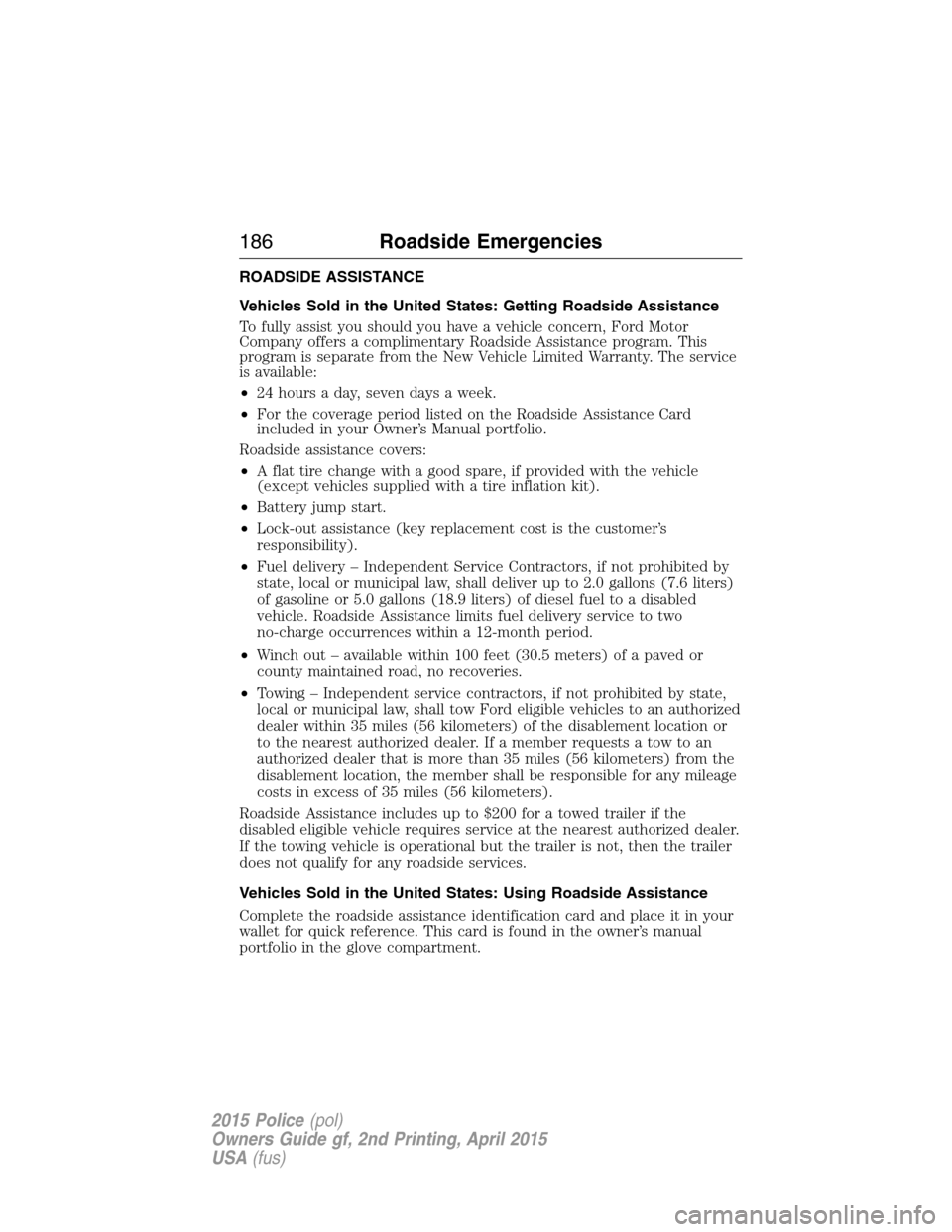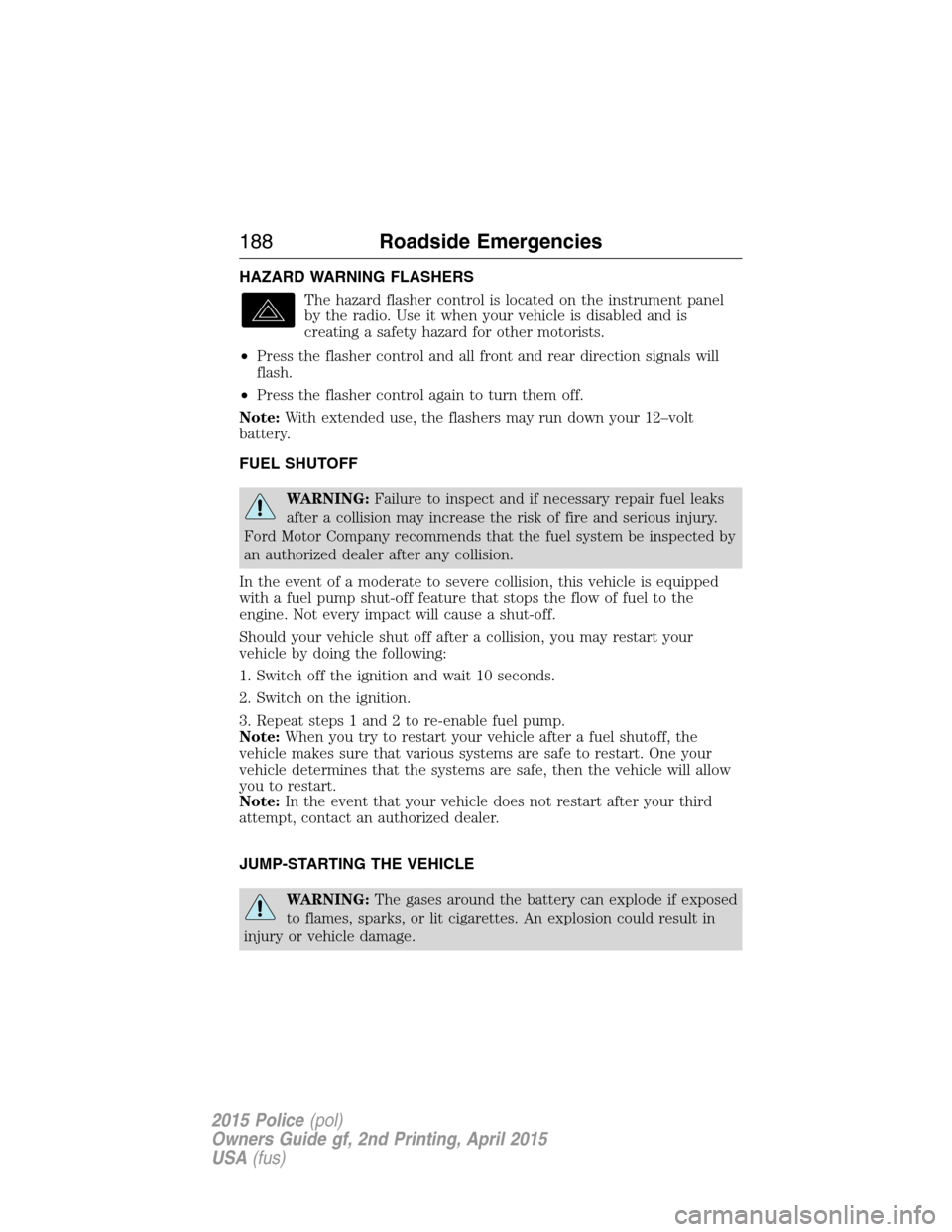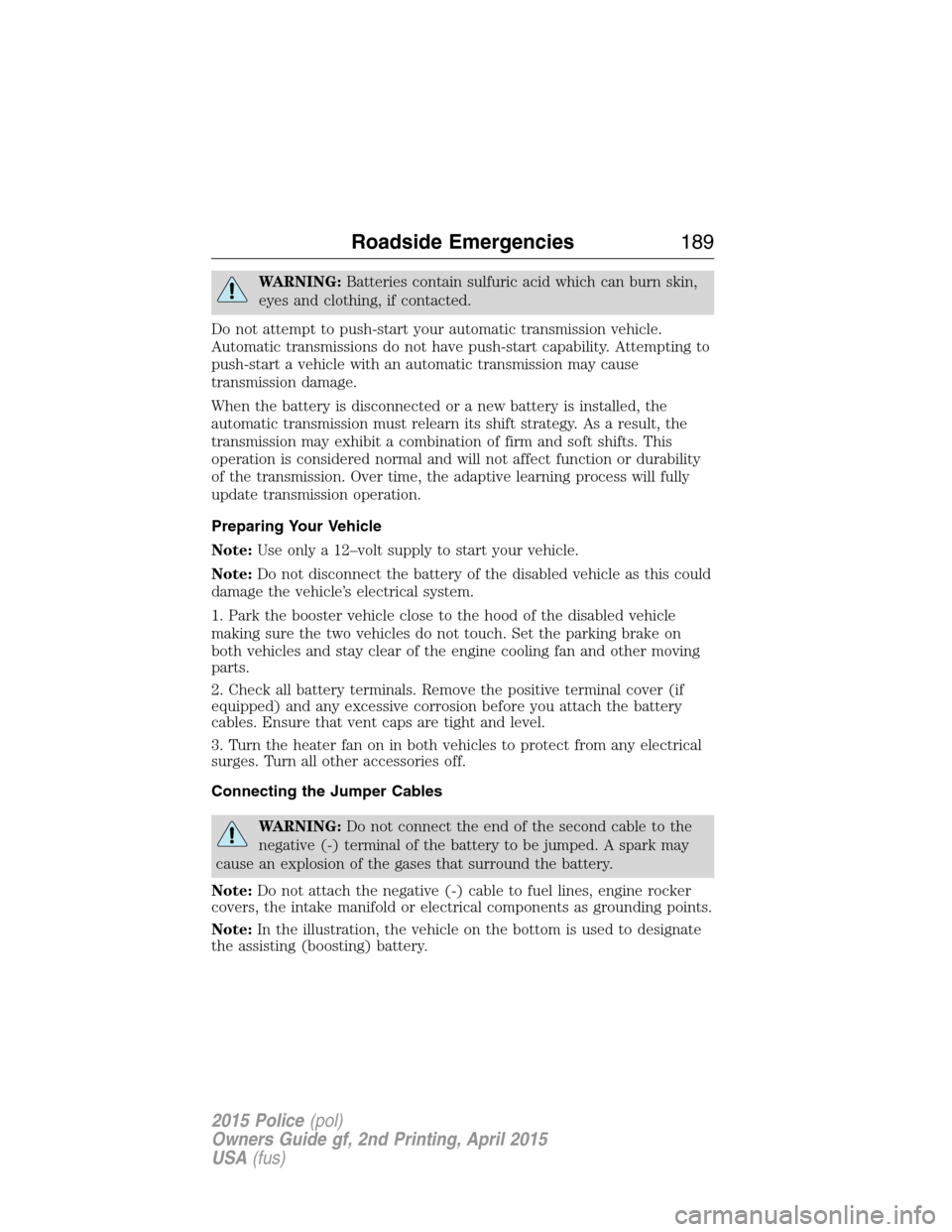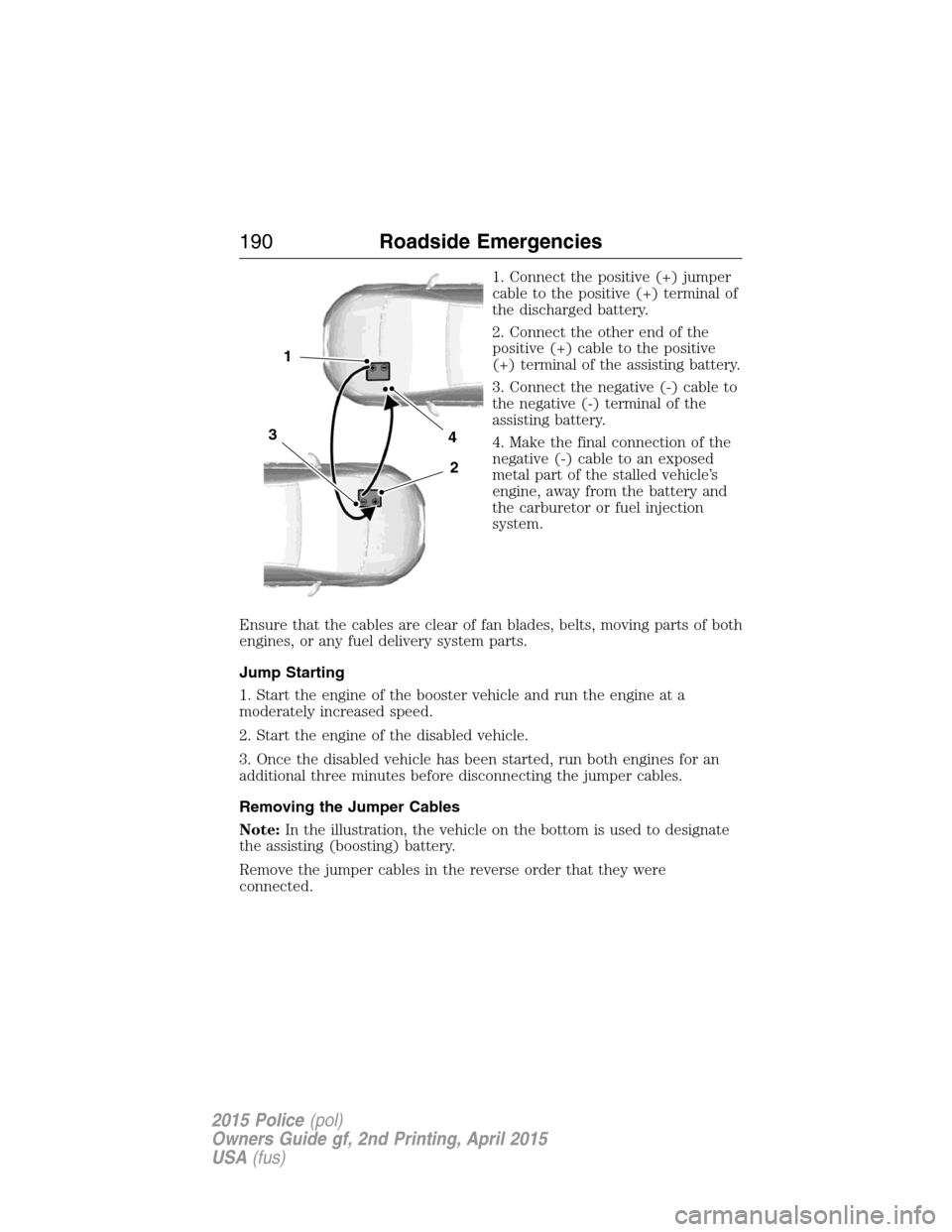2015 FORD POLICE INTERCEPTOR SEDAN jump start
[x] Cancel search: jump startPage 6 of 401

Roadside Emergencies 186
Getting roadside assistance..............................186
Hazard warning flashers................................188
Fuel cut-off switch....................................188
Jump-starting the vehicle...............................188
Customer Assistance 192
Reporting safety defects (U.S. only).......................199
Reporting safety defects (Canada only).....................199
Fuses 200
Changing a fuse......................................200
Fuse specification chart................................200
Maintenance 210
General information...................................210
Opening and closing the hood............................211
Under hood overview..................................213
Engine oil dipstick....................................217
Engine oil check......................................217
Engine coolant check..................................218
Automatic transmission fluid check........................224
Brake fluid check.....................................228
Fuel filter...........................................228
Washer fluid check....................................229
Changing the vehicle battery.............................229
Checking the wiper blades..............................231
Changing the wiper blades..............................231
Air filter(s).........................................232
Adjusting the headlamps................................235
Changing a bulb......................................237
Bulb specification chart.................................245
Table of Contents5
2015 Police(pol)
Owners Guide gf, 2nd Printing, April 2015
USA(fus)
Page 187 of 401

ROADSIDE ASSISTANCE
Vehicles Sold in the United States: Getting Roadside Assistance
To fully assist you should you have a vehicle concern, Ford Motor
Company offers a complimentary Roadside Assistance program. This
program is separate from the New Vehicle Limited Warranty. The service
is available:
•24 hours a day, seven days a week.
•For the coverage period listed on the Roadside Assistance Card
included in your Owner’s Manual portfolio.
Roadside assistance covers:
•A flat tire change with a good spare, if provided with the vehicle
(except vehicles supplied with a tire inflation kit).
•Battery jump start.
•Lock-out assistance (key replacement cost is the customer’s
responsibility).
•Fuel delivery – Independent Service Contractors, if not prohibited by
state, local or municipal law, shall deliver up to 2.0 gallons (7.6 liters)
of gasoline or 5.0 gallons (18.9 liters) of diesel fuel to a disabled
vehicle. Roadside Assistance limits fuel delivery service to two
no-charge occurrences within a 12-month period.
•Winch out – available within 100 feet (30.5 meters) of a paved or
county maintained road, no recoveries.
•Towing – Independent service contractors, if not prohibited by state,
local or municipal law, shall tow Ford eligible vehicles to an authorized
dealer within 35 miles (56 kilometers) of the disablement location or
to the nearest authorized dealer. If a member requests a tow to an
authorized dealer that is more than 35 miles (56 kilometers) from the
disablement location, the member shall be responsible for any mileage
costs in excess of 35 miles (56 kilometers).
Roadside Assistance includes up to $200 for a towed trailer if the
disabled eligible vehicle requires service at the nearest authorized dealer.
If the towing vehicle is operational but the trailer is not, then the trailer
does not qualify for any roadside services.
Vehicles Sold in the United States: Using Roadside Assistance
Complete the roadside assistance identification card and place it in your
wallet for quick reference. This card is found in the owner’s manual
portfolio in the glove compartment.
186Roadside Emergencies
2015 Police(pol)
Owners Guide gf, 2nd Printing, April 2015
USA(fus)
Page 189 of 401

HAZARD WARNING FLASHERS
The hazard flasher control is located on the instrument panel
by the radio. Use it when your vehicle is disabled and is
creating a safety hazard for other motorists.
•Press the flasher control and all front and rear direction signals will
flash.
•Press the flasher control again to turn them off.
Note:With extended use, the flashers may run down your 12–volt
battery.
FUEL SHUTOFF
WARNING:Failure to inspect and if necessary repair fuel leaks
after a collision may increase the risk of fire and serious injury.
Ford Motor Company recommends that the fuel system be inspected by
an authorized dealer after any collision.
In the event of a moderate to severe collision, this vehicle is equipped
with a fuel pump shut-off feature that stops the flow of fuel to the
engine. Not every impact will cause a shut-off.
Should your vehicle shut off after a collision, you may restart your
vehicle by doing the following:
1. Switch off the ignition and wait 10 seconds.
2. Switch on the ignition.
3. Repeat steps 1 and 2 to re-enable fuel pump.
Note:When you try to restart your vehicle after a fuel shutoff, the
vehicle makes sure that various systems are safe to restart. One your
vehicle determines that the systems are safe, then the vehicle will allow
you to restart.
Note:In the event that your vehicle does not restart after your third
attempt, contact an authorized dealer.
JUMP-STARTING THE VEHICLE
WARNING:The gases around the battery can explode if exposed
to flames, sparks, or lit cigarettes. An explosion could result in
injury or vehicle damage.
188Roadside Emergencies
2015 Police(pol)
Owners Guide gf, 2nd Printing, April 2015
USA(fus)
Page 190 of 401

WARNING:Batteries contain sulfuric acid which can burn skin,
eyes and clothing, if contacted.
Do not attempt to push-start your automatic transmission vehicle.
Automatic transmissions do not have push-start capability. Attempting to
push-start a vehicle with an automatic transmission may cause
transmission damage.
When the battery is disconnected or a new battery is installed, the
automatic transmission must relearn its shift strategy. As a result, the
transmission may exhibit a combination of firm and soft shifts. This
operation is considered normal and will not affect function or durability
of the transmission. Over time, the adaptive learning process will fully
update transmission operation.
Preparing Your Vehicle
Note:Use only a 12–volt supply to start your vehicle.
Note:Do not disconnect the battery of the disabled vehicle as this could
damage the vehicle’s electrical system.
1. Park the booster vehicle close to the hood of the disabled vehicle
making sure the two vehicles do not touch. Set the parking brake on
both vehicles and stay clear of the engine cooling fan and other moving
parts.
2. Check all battery terminals. Remove the positive terminal cover (if
equipped) and any excessive corrosion before you attach the battery
cables. Ensure that vent caps are tight and level.
3. Turn the heater fan on in both vehicles to protect from any electrical
surges. Turn all other accessories off.
Connecting the Jumper Cables
WARNING:Do not connect the end of the second cable to the
negative (-) terminal of the battery to be jumped. A spark may
cause an explosion of the gases that surround the battery.
Note:Do not attach the negative (-) cable to fuel lines, engine rocker
covers, the intake manifold or electrical components as grounding points.
Note:In the illustration, the vehicle on the bottom is used to designate
the assisting (boosting) battery.
Roadside Emergencies189
2015 Police(pol)
Owners Guide gf, 2nd Printing, April 2015
USA(fus)
Page 191 of 401

1. Connect the positive (+) jumper
cable to the positive (+) terminal of
the discharged battery.
2. Connect the other end of the
positive (+) cable to the positive
(+) terminal of the assisting battery.
3. Connect the negative (-) cable to
the negative (-) terminal of the
assisting battery.
4. Make the final connection of the
negative (-) cable to an exposed
metal part of the stalled vehicle’s
engine, away from the battery and
the carburetor or fuel injection
system.
Ensure that the cables are clear of fan blades, belts, moving parts of both
engines, or any fuel delivery system parts.
Jump Starting
1. Start the engine of the booster vehicle and run the engine at a
moderately increased speed.
2. Start the engine of the disabled vehicle.
3. Once the disabled vehicle has been started, run both engines for an
additional three minutes before disconnecting the jumper cables.
Removing the Jumper Cables
Note:In the illustration, the vehicle on the bottom is used to designate
the assisting (boosting) battery.
Remove the jumper cables in the reverse order that they were
connected.
4
2
1
3
190Roadside Emergencies
2015 Police(pol)
Owners Guide gf, 2nd Printing, April 2015
USA(fus)
Page 192 of 401

1. Remove the jumper cable from
the ground metal surface.
2. Remove the jumper cable on the
negative (-) terminal of the booster
vehicle’s battery.
3. Remove the jumper cable from
the positive (+) terminal of the
booster vehicle’s battery.
4. Remove the jumper cable from
the positive (+) terminal of the
disabled vehicle’s battery.
After the disabled vehicle has been started and the jumper cables
removed, allow it to idle for several minutes so the engine computer can
relearn its idle conditions.
4
1
3
2
Roadside Emergencies191
2015 Police(pol)
Owners Guide gf, 2nd Printing, April 2015
USA(fus)
Page 307 of 401

Roadside Assistance
Exclusive 24/7 roadside assistance, including:
•Towing, flat-tire change and battery jump starts
•Out of fuel and lock-out assistance
•Travel expense reimbursement for lodging, meals and rental car
•Destination assistance for taxi, shuttle, rental car coverage and
emergency transportation
Transferable Coverage
If you sell your vehicle before your Ford Extended Service Plan coverage
expires, you can transfer any remaining coverage to the new owner.
Whenever you sell your vehicle, prospective buyers may have a higher
degree of confidence that vehicle was properly maintained with Ford
ESP, thereby improving resale value.
Avoid the Rising Cost of Properly Maintaining Your Vehicle!
Ford Extended Service Plan also offers a Premium Maintenance Plan
that covers all scheduled maintenance, and selected wear items. The
coverage is prepaid, so you never have to worry about affording your
vehicle’s maintenance. It covers regular checkups, routine inspections,
preventive care and replacement of select items that require periodic
attention for normal wear:
•Windshield wiper blades
•Spark plugs (except in California)
•The clutch disc
•Brake pads and linings
•Shock absorbers
•Belts and hoses
•Diesel exhaust fluid replenishment
Contact your selling authorized Ford or Lincoln dealership today so they
can customize a Ford Extended Service Plan that fits your driving
lifestyle and budget.
306Extended Service Plan
2015 Police(pol)
Owners Guide gf, 2nd Printing, April 2015
USA(fus)
Page 396 of 401

C
Capacities for refilling fluids ....296
Cargo management system ......165
CD ..............................................310
CD player ..................................308
Cell phone use ............................16
Changing a tire .........................284
Child safety restraints ..........28, 31
Child safety seats
attaching with tether straps ....31
automatic locking mode
(retractor) .................................38
LATCH .......................................28
Child safety seats - booster
seats .............................................22
Cleaning your vehicle ...............248
engine compartment ..............250
instrument panel ....................252
interior .....................................252
plastic parts ............................250
washing ....................................248
waxing .....................................250
wheels ......................................254
wiper blades ............................251
Climate control (see Air
conditioning or Heating) ..........107
Clock ..........................................310
Console ......................................118
overhead ..................................119
Coolant ......................................218
checking and adding ..............218
refill capacities ........................296
specifications ..........................296
Cross Traffic Alert ....................158
Cruise control ...........................156
Customer Assistance ................186Ford Extended Service
Plan ..........................................305
Getting roadside assistance ...186
Getting the service you
need .........................................192
Ordering additional owner’s
literature .................................198
Utilizing the
Mediation/Arbitration
Program ...................................196
D
Defrost .......................................107
rear window ............................108
Dipstick
automatic transmission
fluid ..................................224, 227
engine oil .................................217
Driving under special
conditions ..................138, 142, 144
sand .........................................143
snow and ice ...........................145
through water .................144, 184
E
Electronic message center .........98
Electronic stability control ......151
Emergencies, roadside
jump-starting ..........................188
running out of fuel .................128
Emergency brake
(see Parking brake) ..................148
Emission control system ..........133
End user license agreement ....366
Engine ........................................294
cleaning ...................................250
coolant .....................................218
fail-safe cooling .......................222
Index395
2015 Police(pol)
Owners Guide gf, 2nd Printing, April 2015
USA(fus)